赖世雄语法笔记
- 格式:doc
- 大小:238.50 KB
- 文档页数:29
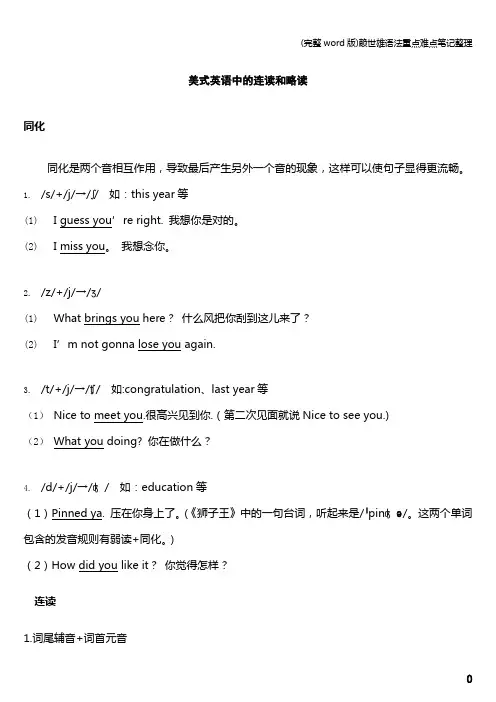
美式英语中的连读和略读同化同化是两个音相互作用,导致最后产生另外一个音的现象,这样可以使句子显得更流畅。
1./s/+/j/→/ʃ/ 如:this year等(1)I guess you’re right. 我想你是对的。
(2)I miss you。
我想念你。
2./z/+/j/→/ʒ/(1)What brings you here?什么风把你刮到这儿来了?(2)I’m not gonna lose you again.3./t/+/j/→/ʧ/ 如:congratulation、last year等(1)Nice to meet you.很高兴见到你.(第二次见面就说Nice to see you.)(2)What you doing? 你在做什么?4./d/+/j/→/ʤ/ 如:education等(1)Pinned ya. 压在你身上了。
(《狮子王》中的一句台词,听起来是/ˈpinʤə/。
这两个单词包含的发音规则有弱读+同化。
)(2)How did you like it?你觉得怎样?连读1.词尾辅音+词首元音这种连读最常见也最简单,把相邻的两个单词想象成一个单词即可。
(1)I’m so fed up with him。
他让我烦透了.(2)I’ve already made up my mind. 我意已决。
(3)That is so gross [ɡrəus].太俗了。
(4)Turn on the juice. 合上开关,恢复通电。
(juice也有电的意思)2.词尾元音+词首元音A:以/u/、/ʊ/、/au/、/o/结尾的单词与跟在后面的元音连读时,两个元音之间加上一个较轻的/w/,这样过渡就会很自然。
(1)Just do it. 尽管去做吧!(2)It’s snowing. 下雪了。
(3)Don't blow it。
别搞砸了。
(4)So easy. 太简单了。
B:如果单词结尾是/i/、/ai/、/e/结尾并与其后的元音连读,则两个元音见带上一个较弱的/j/。
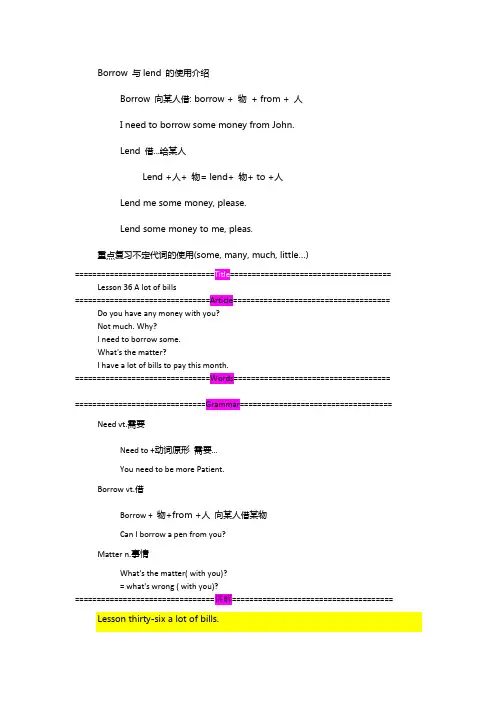
Borrow 与lend 的使用介绍Borrow 向某人借: borrow + 物+ from + 人I need to borrow some money from John.Lend 借...给某人Lend +人+ 物= lend+ 物+ to +人Lend me some money, please.Lend some money to me, pleas.重点复习不定代词的使用(some, many, much, little…)===================================================================== Lesson 36 A lot of bills===============================Article==================================== Do you have any money with you?Not much. Why?I need to borrow some.What's the matter?I have a lot of bills to pay this month.===============================Words==================================== ==============================Grammar=================================== Need vt.需要Need to +动词原形需要…You need to be more Patient.Borrow vt.借Borrow + 物+from +人向某人借某物Can I borrow a pen from you?Matter n.事情What's the matter( with you)?= what's wrong ( with you)?================================讲解===================================== Lesson thirty-six a lot of bills.Hello this is Peter Lai again. Very happy to be on the air. Now let's open this book to page one hundred fifty-seven. Page one hundred fifty-seven on this page we can see lesson thirty-six "A lot of bills."A lot of 后可以放复数名词或不可数名词.He has a lot of money. I have a lot of time.He has a lot of friends.而否定要用much.He doesn't have much money. = he doesn't have a lot of money.而肯定句尽量用a lot of.否定句用a lot of, much都可以He doesn't have much time. 他没有许多的时间.不要用在肯定句:He has much time. He has much money. 错错错.Much 多与not 并用在否定句中Bill 是可数名词" 账单"A bill. Two bills. Many bills.Part on reading.I feel sorry for Al. 我对al表示难过.This is a dialog between a boy by the name of Al and a girl by the name of Sue. Al 和Sue的对话.Al doesn't have much money. I feel sorry for him.他钱不多,我为他感觉难过.I feel sorry for you, John. 我为你感到难过.Do you have any money with you?any用在否定句或疑问句中后放可数不可数名词. 同时放单数,复数都可Do you have any friend/ friends?No, I have no friend/ friends. No后也是可以放单数或复数名词Yes, I do. Have ten dollars with me. 我有10块钱(在身上)With 在be动词后也有用法.She is with Peter now. 他现在跟皮特在一起. (这表示他以前和别人一起的). Now she is with Peter.I don't like to be with him. 我不喜欢和他一起.He doesn't study, he is not a good student. I don't like to be withhim. 他不是五道杠学生,我不喜欢和他一起.How much money do you have with you? 你有多少钱在身上?much用于不可数,many用于可数.How many friends do you have? (没有with you)你有多少朋友?I have twenty dollars with me. 我身上有20块钱.Not much. Why?Yes, I do. But I don't have much money with me. 这简化出来的.Do you have any friends? 你有没有朋友啊?Yes, I do, but I do not have many friends. 我有但不多.Why do you ask me such a question? 你为什么问这狗屁问题?Why 也等于what for.I need to borrow some.Need 的用法之前有介绍过,与want 差不多.我们来复习一下Need to +动词原形. You need to be more careful.你需要更小心.Need +人/物: I need you.我需要你. I need some food.Need + 人+ to +动词原形:I need you to go away.我要你滚蛋.还有need与want的分别记得吗?Need 翻译: 需要(更强烈). Want 翻译: 想要(无可无不可). 在一些情况下可相互代用.I need to 在这等于I want toI want to borrow some.I need to write a letter. I want to write a letter.Borrow 借Borrow +物+ from +人I need to borrow twenty dollars from him.我要跟他借20块.Don't borrow money from him. 不要向他借钱.Lend. 把……借给…Lend + 人+ 物(这有点像授予动词吧)= Lend +物+ to +人不要借钱给他(他从来不还的)Don't lend him any money.Don't lend any money to him.原句写的borrow some 是省略,原句应该是:I need to borrow some money from you.What's the matter?matter在这虽然是名词,但当成形容词用.= wrong.You are wrong. You give me the wrong answer.你错了,你给了我错误的回答.Two and two are four.You are right. 你太聪明了.What's the matter? = what's wrong?What's wrong? Lady.There is nothing wrong/ (the matter).nothing大家还记得: 他的形容词要放后面修饰.这里一样可以放the matter.证明看起来是个名词,实际当形容词用.There's nothing wrong with me.我没问题.他出什么问题了: there is something wrong with him.There is something the matter with him.I have a lot of bills to pay this month.时间副词:To pay this month.看起来好像是: 付这个月. 其实不是This month虽然也是个名词样,但当成时间副词用的. 也可以放在句首This month I have a lot of bills to pay.This +时间名词前面都不需要加介词 .I'll be very busy this week. 这个星期我会很忙.This year I'll be very busy. 今年我会很忙.(这下完了)Pay 支付You should pay the money.你要付这笔钱.You should pay the bill. 你要付这个账单 .轮到你付账了It is your turn. 轮到你啦.It's your turn to pay the bill.练习:Marry is crying.What's the matter with her?What's wrong with her?She doesn't have money.She doesn't have much money.Can you lend me ten dollars?Can you lend ten dollars to me?Don't borrow any money from him.===============================Practice=================================== 这里主要复习不定代词There are ____ pencils on the table.A few, much, little, a little.这里很明显,pencils是复数,所以一下就排队了3个Much 很多. 修饰不可数. 而且用于否定句.Little 没有多少.修饰不可数A little, 有一些. 同样修饰不可数There is little time left. 没剩下多少时间了.There is still a little time. 还有点时间.Few,修饰可数, 没多少A few 有一些, 修饰可数我有一些朋友: I have a few friends.我没几个朋友: I have few friends.We need ____ food for the party.Many, several, a lot, lots of.Many 很多, 修饰可数Several 一些,修饰可数记得课文吗: there are several foreign students in my classA lot of, 很多, 修饰可数不可数Lots of, 就等于a lot of. 但注意看,这里面的选择,没有of.He has a lot of friends. == he has lots of friends.He has a lot of money. == he has lots of money.How ____ students are in the room?Much, few, many, a few.这里how开头表示多少的的疑问句,只有how much/ how many而much问不可数,many 用在可数,所以...There is ____ juice in the refrigerator.Lots, a little, a lots of, many.上面现在都解释过了,所以接下来的应该会了There are many students in the classroom.There are ____children playing in the yard.A little, much, several, severals.There is something ____ with Fred.Matter, the matter, the wrong, what's wrong.这里复习the matter, wrong的使用. wrong是形容词不加冠词================================others===================================。
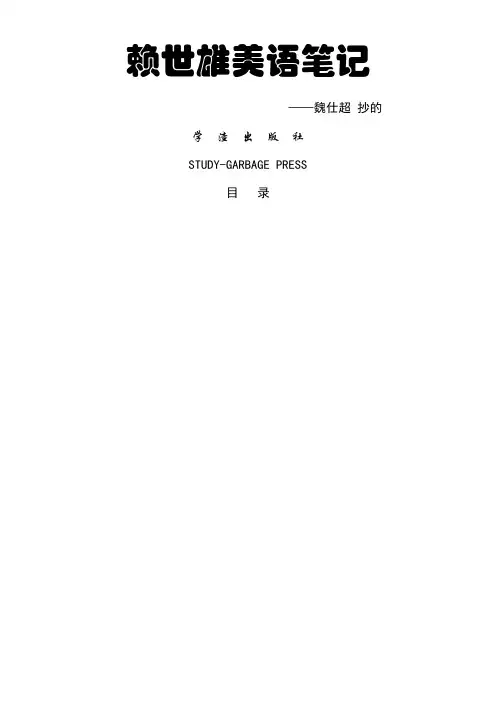
赖世雄美语笔记——魏仕超抄的学渣出版社STUDY-GARBAGE PRESS目录美语入门LESSON 1 greetings词汇:greetings n.问候招呼致意idiom n.短语句子:A:see you later B:alligaterhow are youhow are you doinghow are you getting alonehow have you beenhow's it goingwhat's upwhat's happeningLESSON 2 courtesy词汇:courtesy n.礼貌LESSON 3 what's your name词汇:nationality n.国籍句子:may I have your name please?=what's your name LESSON 4 family name词汇:family name 姓this that these those这个那个这些那些以上为指示代词,也可以有指示形容词的功能,例如this book is goodLESSON 5 how do you do相当于你好,不可以回答I'm fine词汇:occupation n.职业secretary n.秘书pilot n.飞行员句子:how do you do相当于你好,不可以回答I'm fine要说how do you do来回应what do you do你是做什么的LESSON 6 it's five past three词汇:ma'am n.夫人句子:it's five past three=it's three o five三点过五分,十分之后不用加"o"it's twenty to five=it's four fortyLESSON 7月份词汇:January February March April May June July August September October November December句子:June 2 1998这个2不是基数词,是序数词what's today's date今天几月几号LESSON 8 there be句型句子:how's the weather in Beijing=what's the weather like inBeijing表示“有”句首是人或动物应该使用haveI have a book句首是场所或时间,应该用there is/are在there is/are起首的句型中,应该将there视为固定用语,译成“有”而不要译成“那里是”,若要表示“那里/这里有...”应该说there is.....therethere is a man有个人there has a man 无此用法there is a man there 那里有个人LESSON 9 he's not in句子:he's not in他不在“留话”leave/take messageLESSON 10 can I be of any help for you词汇:clinic n.诊所句子:can I be of any help for you?我能帮您什么?LESSON 11 准备好点单了吗词汇:starve v.饥饿,饿死section n.区域,部门句子:are you ready to ordermay I take your order nowLESSON 13 牛排几分熟词汇:dessert n.甜点steak n.牛排book v.登记well done全熟 medium六七分熟 medium rare四五分熟rare3分熟LESSON 14 没重点词汇:brand n.品牌on sale 特价pants n.裤子,短裤pair 一条LESSON 15 量尺寸词汇:词汇:gift-wrap包装句子:take one's measurements量一下尺寸give sb. a hand=do sb. a favor帮忙go over there =go thereover用来加强语气表示就在那LESSON 16 one做代词词汇:high heeled n.高跟鞋clerk n.店员句子:one做代词时代替前面出现过的单数名词,ones代替复数名词LESSON 17 查字典词汇:tale n.故事consult v.查询sold out of n.卖完了句子:consult dictionary 查字典look up the word in dictionary 在字典里查词LESSON 18 here we are词汇:domestic n.国内的speed up 加速句子:here we are我们到了here you are/go 在这,拿去there you again 你又来这一套了LESSON 19 how come词汇:twin adj.成双的,双胞胎的rate n.价格费用lobby n.大厅reservation n.预定句子:how come单独用做“怎么回事”句子里how come I didn't know 是说我怎么不知道rate做“价格”时一般用复数what are your rates...LESSON 20 have a reservation强调预定这件事的事实词汇:suite n.套房charge n.记账bellboy n.男服务生句子:have a reservation强调预定事实make a reservation强调预定动作LESSON 21 兑换外币银行说的话词汇:change v.交换n.零钱cash n.现金v.兑换现金currency n.货币change money换钱change A for B把A换成B句子:how do you want your money?兑换外币时银行对顾客说的话,你要兑换多少面值will my passport do? do原意“做”也可以表示“行”“可以”that'll doseven hundreds eight tens and the rest in change此处的rest是代词,代指“其余的”LESSON 22 问生日和介词用法词汇:reconfirm v.再确认confirmation n.确定depart for动身前往某地intend v.打算book in 登记入住句子:date of birth包含年月日,birthday不包含年份表示确切时间介词用at,表示年月季节上午下午晚上时介词用in,表示日期和星期几介词用onLESSON 23 集合名词和arrive in词汇:lounge n.休息室arrival lounge 入境大厅tax n.税aisle n.通道take off 起飞,升空smoking section 吸烟区句子:arrive at后接小地点如邮局车站等arrive in后接大地点如城市国家英文中两个动词在同一个句子时,必须有连词连接,否则为错,但是go和come 以动词原形出现时则可以省略连词and,直接加另一个动词。
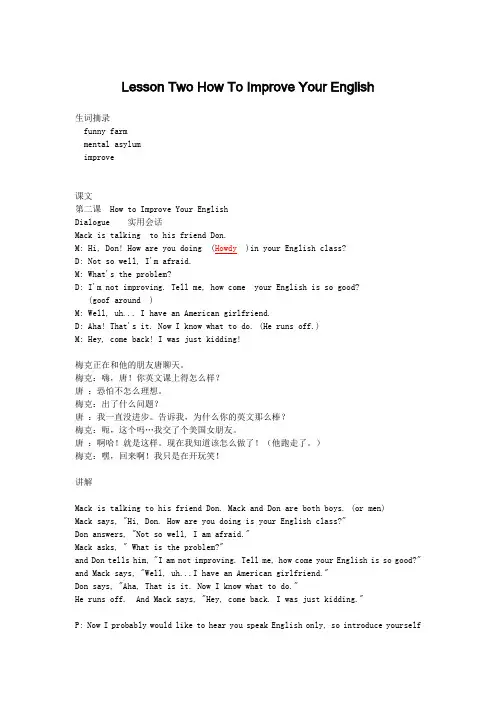
Lesson Two How To Improve Your English生词摘录funny farmmental asylumimprove课文第二课How to Improve Your EnglishDialogue 实用会话Mack is talking to his friend Don.M: Hi, Don! How are you doing (Howdy )in your English class?D: Not so well, I'm afraid.M: What's the problem?D: I'm not improving. Tell me, how come your English is so good?(goof around )M: Well, uh... I have an American girlfriend.D: Aha! That's it. Now I know what to do. (He runs off.)M: Hey, come back! I was just kidding!梅克正在和他的朋友唐聊天。
梅克:嗨,唐!你英文课上得怎么样?唐:恐怕不怎么理想。
梅克:出了什么问题?唐:我一直没进步。
告诉我,为什么你的英文那么棒?梅克:呃,这个吗…我交了个美国女朋友。
唐:啊哈!就是这样。
现在我知道该怎么做了!(他跑走了。
)梅克:嘿,回来啊!我只是在开玩笑!讲解Mack is talking to his friend Don. Mack and Don are both boys. (or men)Mack says, "Hi, Don. How are you doing is your English class?"Don answers, "Not so well, I am afraid."Mack asks, " What is the problem?"and Don tells him, "I am not improving. Tell me, how come your English is so good?" and Mack says, "Well, uh...I have an American girlfriend."Don says, "Aha, That is it. Now I know what to do."He runs off. And Mack says, "Hey, come back. I was just kidding."P: Now I probably would like to hear you speak English only, so introduce yourselfin English againB: Hi, everybody. This is Bruce.P: However, this is basically an English teaching program, so every now and then, of course you will step in and speak Chinese. But most of the time, you will explain the key points, if there is any, in English. So lesson two we will have a short dialogue. Now, by the way, what is meaning of this word "dialogue"?B: A dialogue is a conversation between two people.P: 也就是两个人之间的对话P: And that is spelled?B: conversation or dialogue?P: Dialogue.B: OK. Well, you can see it on page 9 here, "d-i-a-l-o-g-u-e", but it is also spelled "d-i-a-l-o-g". So there are two spellings for this word.哦,有两种拼法 dialogue 这是我们现在看到的拼法,但也有人说dialogP: "dialog", the pronunciation is exactly the same. 发音是完全相同的。
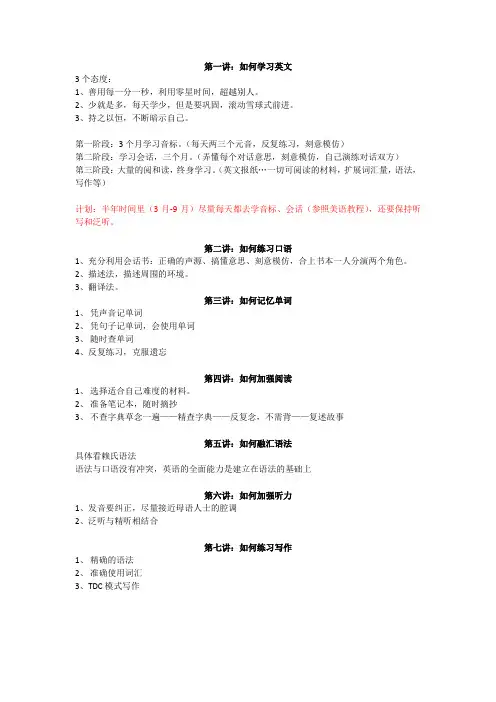
第一讲:如何学习英文
3个态度:
1、善用每一分一秒,利用零星时间,超越别人。
2、少就是多,每天学少,但是要巩固,滚动雪球式前进。
3、持之以恒,不断暗示自己。
第一阶段:3个月学习音标。
(每天两三个元音,反复练习,刻意模仿)
第二阶段:学习会话,三个月。
(弄懂每个对话意思,刻意模仿,自己演练对话双方)
第三阶段:大量的阅和读,终身学习。
(英文报纸…一切可阅读的材料,扩展词汇量,语法,写作等)
计划:半年时间里(3月-9月)尽量每天都去学音标、会话(参照美语教程),还要保持听写和泛听。
第二讲:如何练习口语
1、充分利用会话书:正确的声源、搞懂意思、刻意模仿,合上书本一人分演两个角色。
2、描述法,描述周围的环境。
3、翻译法。
第三讲:如何记忆单词
1、凭声音记单词
2、凭句子记单词,会使用单词
3、随时查单词
4、反复练习,克服遗忘
第四讲:如何加强阅读
1、选择适合自己难度的材料。
2、准备笔记本,随时摘抄
3、不查字典草念一遍——精查字典——反复念,不需背——复述故事
第五讲:如何融汇语法
具体看赖氏语法
语法与口语没有冲突,英语的全面能力是建立在语法的基础上
第六讲:如何加强听力
1、发音要纠正,尽量接近母语人士的腔调
2、泛听与精听相结合
第七讲:如何练习写作
1、精确的语法
2、准确使用词汇
3、TDC模式写作。
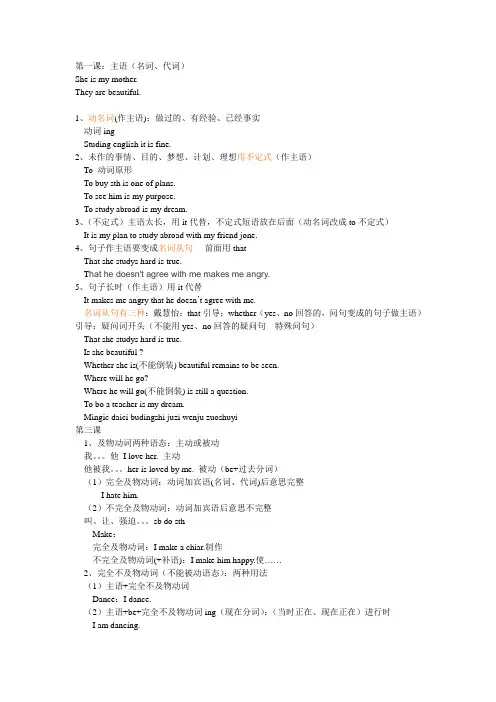
第一课:主语(名词、代词)She is my mother.They are beautiful.1、动名词(作主语):做过的、有经验、已经事实动词ingStuding english it is fine.2、未作的事情、目的、梦想、计划、理想用不定式(作主语)To 动词原形To buy sth is one of plans.To see him is my purpose.To study abroad is my dream.3、(不定式)主语太长,用it代替,不定式短语放在后面(动名词改成to不定式)It is my plan to study abroad with my friend jone.4、句子作主语要变成名词从句----前面用thatThat she studys hard is true.T hat he doesn't agree with me makes me angry.5、句子长时(作主语)用it代替It makes me angry that he doesn’t agree with me.名词从句有三种:戴慧怡:that引导;whether(yes、no回答的,问句变成的句子做主语)引导;疑问词开头(不能用yes、no回答的疑问句---特殊问句)That she studys hard is true.Is she beautiful ?Whether she is(不能倒装) beautiful remains to be seen.Where will he go?Where he will go(不能倒装) is still a question.To bo a teacher is my dream.Mingic daici budingshi juzi wenju zuoshuyi第三课1、及物动词两种语态:主动或被动我。
他I love her. 主动他被我。
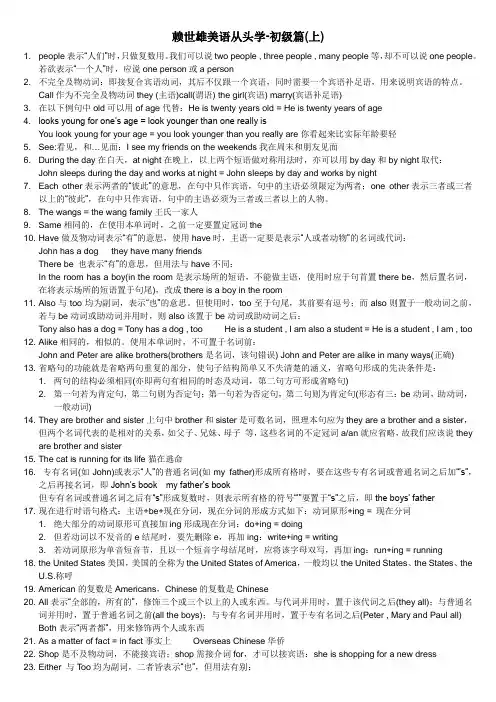
赖世雄美语从头学-初级篇(上)1. people表示“人们”时,只做复数用。
我们可以说two people , three people , many people等,却不可以说one people。
若欲表示“一个人”时,应说one person或a person2. 不完全及物动词:即接复合宾语动词,其后不仅跟一个宾语,同时需要一个宾语补足语,用来说明宾语的特点。
Call作为不完全及物动词they (主语)call(谓语) the girl(宾语) marry(宾语补足语)3. 在以下例句中old可以用of age代替:He is twenty years old = He is twenty years of age4. looks young for one’s age = look younger than one really isYou look young for your age = you look younger than you really are你看起来比实际年龄要轻5. See:看见,和…见面:I see my friends on the weekends我在周末和朋友见面6. During the day在白天,at night在晚上,以上两个短语做对称用法时,亦可以用by day和by night取代:John sleeps during the day and works at night = John sleeps by day and works by night7. Each other表示两者的“彼此”的意思,在句中只作宾语,句中的主语必须限定为两者;one other表示三者或三者以上的“彼此”,在句中只作宾语,句中的主语必须为三者或三者以上的人物。
8. The wangs = the wang family王氏一家人9. Same相同的,在使用本单词时,之前一定要置定冠词the10. Have做及物动词表示“有”的意思,使用have时,主语一定要是表示“人或者动物”的名词或代词:John has a dog they have many friendsThere be 也表示“有”的意思,但用法与have不同:In the room has a boy(in the room是表示场所的短语,不能做主语,使用时应于句首置there be,然后置名词,在将表示场所的短语置于句尾),改成there is a boy in the room11. Also与too均为副词,表示“也”的意思。
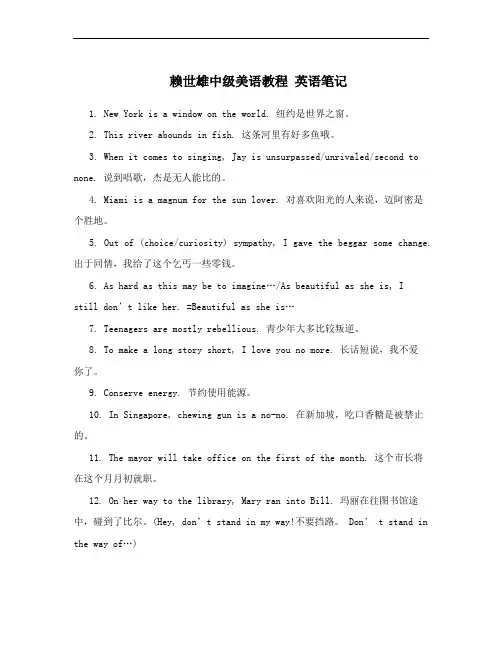
赖世雄中级美语教程英语笔记1. New York is a window on the world. 纽约是世界之窗。
2. This river abounds in fish. 这条河里有好多鱼哦。
3. When it comes to singing, Jay is unsurpassed/unrivaled/second to none. 说到唱歌,杰是无人能比的。
4. Miami is a magnum for the sun lover. 对喜欢阳光的人来说,迈阿密是个胜地。
5. Out of (choice/curiosity) sympathy, I gave the beggar some change. 出于同情,我给了这个乞丐一些零钱。
6. As hard as this may be to imagine…/As beautiful as she is, Istill don’t like her. =Beautiful as she is…7. Teenagers are mostly rebellious. 青少年大多比较叛逆。
8. To make a long story short, I love you no more. 长话短说,我不爱你了。
9. Conserve energy. 节约使用能源。
10. In Singapore, chewing gun is a no-no. 在新加坡,吃口香糖是被禁止的。
11. The mayor will take office on the first of the month. 这个市长将在这个月月初就职。
12. On her way to the library, Mary ran into Bill. 玛丽在往图书馆途中,碰到了比尔。
(Hey, don’t stand in my way!不要挡路。
Don’ t stand in the way of…)13. For me, chocolate is addictive. =I am addicted to chocolate.对于我来说,吃巧克力是会上瘾的。
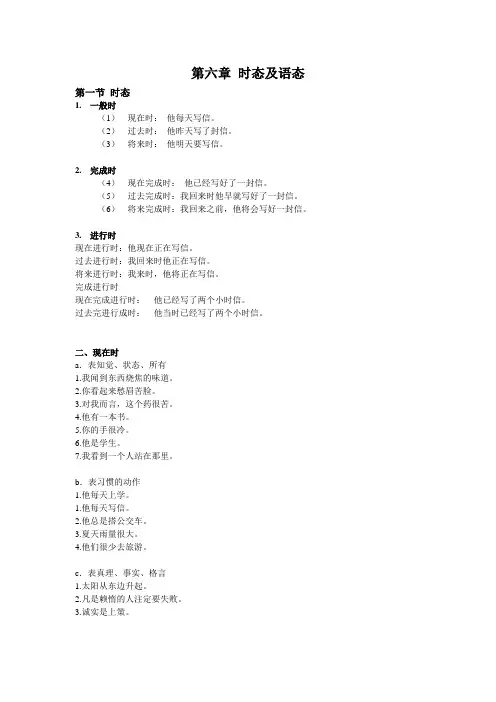
第六章时态及语态第一节时态1.一般时(1)现在时:他每天写信。
(2)过去时:他昨天写了封信。
(3)将来时:他明天要写信。
2.完成时(4)现在完成时:他已经写好了一封信。
(5)过去完成时:我回来时他早就写好了一封信。
(6)将来完成时:我回来之前,他将会写好一封信。
3.进行时现在进行时:他现在正在写信。
过去进行时:我回来时他正在写信。
将来进行时:我来时,他将正在写信。
完成进行时现在完成进行时:他已经写了两个小时信。
过去完进行成时:他当时已经写了两个小时信。
二、现在时a.表知觉、状态、所有1.我闻到东西烧焦的味道。
2.你看起来愁眉苦脸。
3.对我而言,这个药很苦。
4.他有一本书。
5.你的手很冷。
6.他是学生。
7.我看到一个人站在那里。
b.表习惯的动作1.他每天上学。
1.他每天写信。
2.他总是搭公交车。
3.夏天雨量很大。
4.他们很少去旅游。
c.表真理、事实、格言1.太阳从东边升起。
2.凡是赖惰的人注定要失败。
3.诚实是上策。
d.表将来1.他们明天到。
2.7点开始。
3.他们后天出发。
4.他明天要来吗?三、过去时a.表过去的动作、习惯、状态1.我昨天看到他。
2.他从前都很早起床。
3.他生于1970年。
b.表过去的经验(也可以用现在完成进行时表示)你见过他吗?c. 句子中有after,until,before等连词引导的从句,可用过去时代替过去完成时.1.我完成工作之后就回家。
2.我10岁开始学英语。
3.我来这里之前曾在日本住过很长一段时间。
4.他生于1970年。
四、将来时表将来发生的动作或状态:1.明天会下雨。
2.他很快就是学生了。
3.你能来吗?4.我有钱的时候就要买车。
5.除非我有钱,否则我不买车。
6.他将要来。
五、现在完成时1.我刚做完功课。
2.她已经来了。
3.他已经到纽约去了。
---人在纽约。
4.他还没有去工作。
5.我见过他几次。
6.我从未见过像他这样的人。
7她已经在这里住10年了。
--她仍然住在这里。
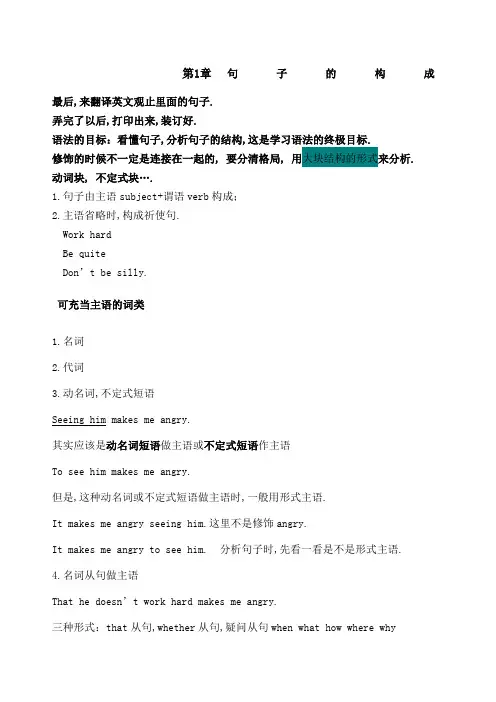
第1章句子的构成最后,来翻译英文观止里面的句子.弄完了以后,打印出来,装订好.语法的目标:看懂句子,分析句子的结构,这是学习语法的终极目标.修饰的时候不一定是连接在一起的, 要分清格局, 用大块结构的形式来分析.动词块, 不定式块….1.句子由主语subject+谓语verb构成;2.主语省略时,构成祈使句.Work hardBe quiteDon’t be silly.可充当主语的词类1.名词2.代词3.动名词,不定式短语Seeing him makes me angry.其实应该是动名词短语做主语或不定式短语作主语To see him makes me angry.但是,这种动名词或不定式短语做主语时,一般用形式主语.It makes me angry seeing him.这里不是修饰angry.It makes me angry to see him. 分析句子时,先看一看是不是形式主语.4.名词从句做主语That he doesn’t work hard makes me angry.三种形式:that从句,whether从句,疑问从句when what how where whyWhere he lives is still a doubt.一、名词从句:名词从句作动词宾语I know that he will go abroad in the nearest future名词从句作动词宾语I don’t know how he’ll handle it.名词从句作介词的宾语I am worried about whether he can do itI am sure of how he’ll cope with the problemI am sure of the fact that the team has won the game.I am worried about the fact that he can do it.这里因为介词+ that从句,所以,需要在介词后加the fact ,that 从句变为the fact的同位语,都是介词的宾语.I am worried about his playing around all day.I am worried about his not studying.这里,介词后边的还是宾语,其实是由that 引导的.但是介词加that从句,需要变换,所以变成这样了.原句是:that he plays around all >his playing around all day.that he not > his not studying.变化的过程中,去掉that,助动词,变所有格,动词变成动名词.that he doesn’t study-> his not studying.That the team will win the gamethe team’s winning the game.be + adj. + that 从句I am worried that he plays around all day.状语从句,修饰形容词I am sure that the team has won the game状语从句.有时,介词后也可以直接加that从句.是固定的.In that = becauseExcept thatHe is great in that he can speak five different languages.二、名词短语做主语名词短语:疑问词+不定式短语Where to liveWhether to try again.When to talk to hime三、表距离的地点副词短语做主语From ...to …It is about 160 kilometers from Beijing to Xiamen.动词的种类及其用法完全complete 及物intransitive 两种修饰,出来4个形态,还有一个是授予动词Dative,所以总共有5种动词.A transitive verb has a direct object. 动词及物的; 传递;及物动词1.完全不及物动词判断方法:把动词放入中间.我...他他被我..两句都没有毛病的及物,有毛病的,不及物.如kill 我杀他他被我杀,可以,为及物动词Dance 我跳他,他被我跳,不及物动词有的动词既是及物动词,又是不及物动词.如kill 有杀某人,也有杀戮的意思,前者是及物,后者是不及物动词2.不及物动词+同源名词有些不及物动词,以同源名词作宾语后,可以变为及物动词Dream a terrible dream.Live a happy lifeSmile a bright smile.3.完全及物动词与完全不及物动词完全及物动词需要加宾语的动词:即加了宾语后,意思完全.He killed her. 有一个作用对象的动词.完全不及物动词无需加宾语:He laughed.The book was written by himThe book :主语,此时,为write的对象.He wrote a book.4.完全不及物动词出现的形态.Something happened.过去时Something was happening. 进行时.完全不及物动词:完整的动词,放在主语后,可单独存在,意义完整,无需任何词类补充其意思的不足;但,完全不及物动词之后,可接副词或副词对等语如介词短语,状语从句,以修饰该动词.Something happened yesterday. 时间名词作状语,修饰happened.这里,yesterday做时间状语He died in an accident. 介词短语,做副词,修饰died.He left because he didn’t want to see Mary again.状语从句,做副词,修饰left5.不完全不及物动词即,系动词,意思不完全,无法单独存在,周后要接名词、形容词的对等语如代词,动名词,不定式,动名词从句,名词短语等,以补充其意思的不足.此类补足语,同时修饰主语,故称为主语补足语或表语.He looks happy. Look是系动词,形容词happy做补语,做主语补语.He became a good student. 名词做补语,做主语补语,修饰主语.My trouble is that I have no money 名词从句做补语,做主语补语.He is in danger now. 介词短语做补语,做主语补语.6.不完全不及物动词的判定方法系动词我...他他被我...如become1确定及物不及物我变成他他被我变成.所以为不及物动词2确定完全不完全.主语+动词主语+be+动词-ing我变成我在变成...所以为不完全动词...综上为,不完全,不及物动词,需要加补语.什么是完全,即看看要不要加补语.7.不完全不及物动词的种类及其主语补语用法系动词7.1be动词be动词后用名词对等语名词,名词从句,名词短语,动名词,不定式,形容词做形容词的现在分词,过去分词,介词短语,地点副词或地点副词短语做补语.Be动词的三种翻译:名词作补语时,翻译为“是”;形容词做补语时,be动词,不翻译;地点副词或地点副词短语做补语时,be动词,翻译为“在”.He is a great hero 名词作补语.The problem is whether he can join us 名词从句做补语.The question is when to set off 名词短语做补语.My hobby is collecting stamps. 做名词用的动名词短语,即名词,做补语My purpose is to see him. 做名词用的不定式短语,即名词,做补语.She is beautiful. 形容词做补语.The question is interesting. 做形容词用的现在分词做补语.I am interested in the question.做形容词用的过去分词做补语.The book is of no use.做作形容词用的介词短语做补语.Of+抽象名词形容词She is there.地点副词做补语.They are upstairs.地点副词做补语.Is he home now地点副词做补语.Be 动词后的现在分词有两种形式:做形容词,做动词.形容词时,翻译为“...的”动词时,翻译为“正在...”Be 动词后的过去分词也有两种形式:形容词,动词的被动语态.形容词时,翻译为:……的.动词时,翻译为:被……是哪个词性的判断方法:把be动词后面的和主语互换,看能不能换.He is washing the car.换了以后:Washing the car is he.不可以,所以是现在分词,不是动名词.His job is washing cars.换了以后:Washing cars is his job.可以,所以,是动名词,动词短语做主语. Whether从句做及物动词的宾语时,名词从句连接词whether可用if代替.I don’t know whether the typhoon will come.= I don’t know if the typhoon will come. Whether引导的名词从句,作宾语.介词之后无宾语时,可单独存在做副词使用,和地点副词一样,有形容词的功能,也可以作为be动词之后的补语.He is in.介词副词.He is in the house 地点副词短语,有形容词功能,做补语.强迫/要求/催促...此类动词+宾语+不定式短语.此时,不定式短语宾语补足语.I forced him to recite the lesson. 不定式短语做宾语补足语,即修饰宾语.I asked him to write the letter. 不定式短语做宾语补足语,即修饰宾语.He was asked to write the letter 不定式短语修饰主语,做主语的补语.任命动词:选举,指派,宾语之后用表支委的名词作补语,通常该名词之前要省略冠词.Elect ,assign.We elected him chairman of the committee.We assigned him platoon leader.认定动词:即,表“视……为”的意思,加了宾语以后,用名词或形容词做宾语的补语We regard him as a geniusWe take him for a genius.We consider him to be a genius.也可以省略to beWe consider him a genius.一般介词之后只能用名词或动名词做宾语,但表示“视……为”意思的动词与介词as或for连用时,该介词之后省略了动名词being,而直接连接形容词与其后.所以,动词表“视……为”的意思时,后面的介词后直接加形容词.其他情况,加名词或动名词.I regard him as niceadj. 介词后的形容词,做宾语的补语虚宾语:Think,believe,find,deem,consider这五个动词做不完全及物动词时,不得直接用不定式短语做宾语,一定要用虚宾语,即it取代.主语+think+it+宾语补语+to V真宾语I think it necessary to do the job.It是形式宾语,necessary 形容词,做宾语的补语,to do the job 真正的宾语.但find, believe, think, deem, consider也可做完全及物动词,此时要用that 引导的名词从句做宾语.I believe that it is worthwhile to study hard. 宾语从句做宾语有时,that从句做及物动词的宾语时,that可以省略.I believe it is worthwhile to study hard. 省略that的宾语从句做宾语. Make 表示“使……成为”时,为不完全及物动词,此时不定式短语不能做宾语,必须要用It做形式宾语.He make it a rule to get up early. 不定式做真宾语 it做形式宾语,a rule 做宾语补语.授予动词授予动词有两个宾语:第一个宾语做间接宾语,表授予的对象,第二个宾语做直接宾语,表授予的东西.I will give you his watch. you 做间接宾语,his watch做直接宾语.直接宾语与间接宾语倒置的方法:1.表“给予”的意思,用to.I gave him the books.= I gave the books to him.2.表“代劳”的意思,用forI made him a chair. == I made a chair for him.3.表“从……中”用of.I asked him a question I aske a question of him.He required nothing of me. 这里me 和 nothing都是宾语,不是做修饰.与授予动词并用的ofHe robbed me of my money. me和my money是宾语,但是rob时,对象是Of前面的.表“提供”的授予动词.Offer,proviede,除offer以外,要和介词with 连用.He offered me all I needed. Me 间接宾语,all I needed直接宾语.He provided me with all I needed = He provide all I needed for me. Present时,用to.He presented a watch to me = He presented me with a watch.第2章句子的连接破折号破折号,连接句子或同位语.第一种用法:补充第一个句子.用来强调第一个从句,补充意思的不足,翻译为“也就是说”,“换句话说”. He is a trash—he is good for nothing.破折号前后都是句子,翻译为:他是个垃圾,换句话说,他什么都不是.第二种用法:连接同位语His hobby—taking pictures—is a far cry from mine.此时,不能His hobby—taking pictures is a far cry from mine.He finally made his purpose known to us—to run after Susan不定式,做purpose的同位语,即,放在修饰后面.不是直接连接一起的.冒号冒号连接句子时,强调句子中的名词.He has made his goal known: he wants to be a scientist.分号分号=,+连词He is a man of principle, so we all respect him.He is man of principle; we all respect him.句号代替逗号.He said that he had no money; that, because of his ill temper, he had no friends to count on; and that he expected me to help him.Because of his ill temper是插入语.He said that he had no money, that he had no friends to count on, and that he expected me to help him.有三个that从句,做said的宾语,叫做,并列从句,用逗号相隔.加上插入语 because of his ill temper时,怎么插呢,插在中间时,因为插入语会引入两个逗号,这样就看不出来,哪个是并列从句,哪个是宾语,所以加上分号.这样一看就看出来是并列的宾语.He said that he had no money; that, because of his ill temper, he had no friends to count on;and that he expected me to help him.划线的是said的三个that宾语从句.He enjoys dancing, swimming and jogging.加上插入语后.He enjoys dancing, which is his hobby; swimming; jogging.或者:He enjoys dancing; swimming, which he often does on Sundays; and jogging.或者:He enjoys dancing, which is his hobby; swimming, which he often does on Sundays; and jogging.并列连词And ;or;but;not only..but also;rather than1.连接单词词,只有三个and or ,butHe is kind and handsome.并列连词做主语补语.2.连接短语He came to see him and tell him the truth. 并列的不定式短语.第二个to省略了,找不到的一般是省略了.He came to see him and to tell him the truth.4.连接句子He succeeded both because he was intelligent and because he worked hard.并列的状语从句.Not only can she sing, but he can dance. 并列的句子.连词的独立用法:此时是根据上下文.….And he took my advice.连接副词只能用于连接句子和句子之间,即连接从句.I like him because he is easy to get along with.When he came , I was writing a letter.这里是,连接副词.常用的连接副词:because, though, if, unless, as soon as, when, once等等.连接副词引导状语从句,修饰主句.连接副词冠于任何一个从句前面,该从句就成为一个状语从句,即状语从句.状语从句不能单独存在,需要依赖主句,整个状语从句可视为副词,用来修饰主句.I like him because he is nice 状语从句,修饰主句.Because he is nice, I like him.任何一个连接副词引导的状语从句置于主句之后,两句间不置逗号,若,状语从句置于主句之前,则两句间通常置逗号.Though he did poorly on the exam, his father didn’t blame him.= His father didn’t blame him though he did poorly on the exam.偶尔,当然,有的人也可以加逗号的,只是不专业.His father didn’t blame him, though he did poorly on the exam.连接性副词:即,副词有连词的意味,但却不能做连词用,此类副词称为连接性副词;此类副词前要有分号,用以连接两个句子,即不加分号时,看着就不对.He is nice; however I don’t like him.He is kind; we, therefore, like him. 一样的,此时把however插入到句子中.即.He is nice; however I don’t like him=He is nice; I , however, don’t like him. 就是把逗号换成分号而已.While做连接副词及并列连词表“当……”时,while视为连接副词,引导状语从句;表“而……”时,视为并列连词,引导主句.He is nice, while his brother is bad. 并列连词.While he is nice, his brother is bad. 把while提前了,但意思时一样的,都是引导主句.He is nice 和his brother is bad 都是两个主句.While I was writing a letter, she was doing dishes.While I was writing a letter做状语从句She was doing dishes 主句.第3章关系词关系代词relative pronoun 关系代词;相对的代词.关系代词有连词的功能,用以引导定语从句.He is a man who always means what he says.Who指代a man这个词.That’s the book which I like.Which 指代the book这个词.He works hard, which is a fact that we all know.Which前有逗号,所以which指代的是he works hard这个句子.That指代的是a fact.指代人时,主格用who,即在who引导的定语从句中做主语,宾格用whom,即,在所引导的定语从句中做宾语.Which主格宾格都是which,代替事物和句子时也都是which关系代词之前要有它要代替的先行词;关系代词在所引导的定语从句中要做主语、宾语或be动词的补语补语只有be动词有;否点关系代词之前一定要用介词.He is a good student who studies hard.Who指代student,在所引导的定语从句who studies hard中,who是主语,studies 是谓语,hard做状语.He is a boy whom everyone loves.Whom指代 a boy,在所引导的定语从句whom everyone loves中whom做及物动词loves的宾语,everyone做主语.He is a man for whom I enjoy working.Whom指代a man ,所引导的定语从句for whom I enjoy working中I做主语 enjoy 做谓语,working做宾语,所以for whom什么都不做,即关系代词之前有介词即表示,只是一个连接词,什么成分都不做,但翻译时要翻译出来.He is a man for whom I enjoy working他是一个我很乐意为他工作的人.He is man with whom I enjoy working.The house in which we live is very largeWhich指代the house ,引导的定语从句we是主语,in which we live中,live为不及物动词,所以which什么都没做,就需要在前面加上介词,怎么在关系代词前面加介词呢,看后面的谓语live而加上去.关系代词之前有介词时,介词可移动到所引导的定语从句末尾,此时可省略关系代词.即关系代词的省略.只是移动到所引导定语从句的末尾,而不是整个句子.还原的时候找先行词的位置,加上去即可.He is a man I enjoy working with. A man 是先行词,在后面加上关系代词即可,疑问是,什么都不做,为什么要用宾格呢,有介词要用宾格He is a man whom I enjoy working with.He is a man with whom I enjoy working.The house we live in is very large. 找到先行词the house在后面加上which The house which we live in is very largeThe house in which we live is very large.有些固定的动词短语,即动词+介词/动词+名词+介词,在定语从句中出现时,介词不能置于关系代词之前,以保持该动词的完整性.如,pay attention to ; call on; take over; warm up等有介词的动词短语. This is a question you should pay attention to .This is a question which you should pay attention to .This a question to wich you shoud pay attention.但这个句子不好,不要这么写.John, who was lazy,scored quite high marks on the exam, which somewhat surprised me.Which前面有逗号,所以代表整个句子 .那中间的插入语时怎么回事呢,只要是个句子,或者短语都可以做为插入语,或者看着像非限制性定语从句.We spread our clothes in the sun to dry, which they did very quickly.这里有逗号which, they 指代our clothes, which代替了dry的概念,这里,which指代了前句中的部分概念.所以逗号+which可能是指代前面的一整句,或者指代前句中的部分概念.限制性定语从句和非限制性定语从句,即独一无二的就不能限定,比如妈妈,爸爸只有一个就不能限定.专有名词或独一性名词本身就有特殊性,不用再用形容词来限定.I met John, who is my classmate.I went to the train station this morning,写到这里,下边一句可以用非限制性定语从句来修饰其中的某个概念,这样就不用直接加which,还不知道修饰的什么.当不知道要定语从句要怎么加在后面时,这时,可以用非限制性定语从句来修饰.所以这里我想修饰一下the train station就可以用非限制性定语从句.I went to the train station this morning, which was crowded witch passengers.限定修饰:一些名词本身未具有特殊性,可用定语从句加以限定修饰,以加强其特殊性.限定修饰的定语从句,其关系代词前不用逗号.翻译时,限制性的定语从句要先翻译定语从句部分,再翻译被修饰的部分.当时是直到翻译名词时,再用修饰来修饰名词.He is a boy who works hard.限定性的定语从句,翻译时先翻译后面的定语从句部分,而who就不要翻译.他是工作认真的一个男孩.当然也可以用非限制性定语从句.限制的可以用非限制,非限制的不能用限制.\为什么呢,因为这时,一般名词已经有形容词在修饰了.比如.He is a good boy, who works hard.关系代词的省略.This is the boy I saw yesterday.This is the boy whom I say yesterday. 即,关系代词做宾语时,可以省略.还有就是关系代词是介词的宾语,介词移动到句尾时,关系代词也可以省略.This is the house we lives in.This is the house which we lives in.This is the house in which we lives.That做关系代词That可以做关系代词,去到who whom which,但that做关系代词时,不能有逗号,即只能用在限制性定语从句中,也不能用于有介词的定语从句中.I like the girl that is sitting there.I like the girl who is sitting there. 为限制性定语从句 that is sittingthere是修饰作用的,不止是一个句子,还是一个定语从句.He is a man that we all respect.He is a man whom we all respect.还有一种情况是定语从句中不能用who whom which,只能用that.The first man that came here was Peter. That came here was Peter是一个限制性定语从句,这里前面有一个first,即序数词,所以后面只能用that做定语从句的引导词.Who is the man that is standing there 这里前面有疑问词who,所以用who,which ,whom的话会重复,只能用that.这里that引导的that is standing there做定语从句修饰 man.除了who之外,还有what where how 之后也只能用that.He is the best student that I’ve ever taught.这里有最高级,后面也只能用that.He is the very man that I met yesterday.The very+名词后面也只能用that.…..还有几种情况,但不了解了,我的目的是看懂文章,不用理那么多,只要记住,that还可以引导定语从句.限定修饰的定语从句简化为分词短语:The girl dancing here yesterday is my sister.其实原来是一个定语从句== who danced here yesterday.所以分词短语有时也是一种定语从句.非限制性定语从句不可简化为分词短语.I met John, who said that he loved Mary very much.这里不可等价于 saying that…但是,非限制性定语从句可简化为先行词的同位语I met John, a good friend of mine.I met John, who is a good friend of mine.这里,a good friend of mine是John的同位语,相当于一个非限制性定语从句.即去掉who或which+和be动词之后就可以变成同位语.He works hard, a fact known to us.He works hard, which is a fact known to us.He works hard, a fact t hat is known to us.He works hard, which is a fact that is known to us.A good friend of mine, John came to see me yesterday.John, a good friend of mine, came to see me yesterday.这里a good friend of mine是John的同位语.主语的同位语可置于主语前或者后的位置.什么是插入语即主语+表认知的动词.其他的都是非限制性定语从句,或其省略.I believe ; I think; I fell; I know; I consider; I find.He is a man who I think never breaks his word.I think 是插入语,who没有变成whom 因为who还是never breaks his word的主语.He is the man whom I believe I met yesterday.当然有时,还是可以做后面的宾语的.He is a man whom I think to be nice.Whom做think的宾语 to be nice做whom的宾语补语.He has no house to live in. 这里to live in实际上是一个定语从句.= He has no house in which to live.Lend me your pen to write my address with.= Lend me your pen with which to write my address.To write my address with是定语从句.关系代词的所有格关系代词所有格和关系代词一样,引导定语从句,修饰前面的名词.She has an uncle whose name is PeterShe has an uncle. His name is Peter.可以断句,即关系代词的所有格,基本上可以断句处理.但是翻译的时候也可以一句话一起翻译.他有一个名叫做Peter的叔叔.还是定语从句.其实是这样的,想要在先行词后再接一个名词时,就可以用关系代词的所有格来进行处理.I like that house, whose location looks good to me.I like that house. Its location looks good to me.关系代词所引导的名词要做定语从句中的主语或宾语.I hate John, whose words are seldom true.Whose words做定语从句中的主语.I hate John, whose words I don’t believe.Whose words做定语从句中的宾语.I hate John, whose words I have no trust inHave及物动词 no trust 宾语 whose words 什么都不做,所以需要在关系代词之前要加介词in.I hate John, in whose words I have no trust.即,关系代词引导的什么都不做时,要在前面后末尾加上介词,分析的时候要注意,什么都不做的这种情况,其实一种做法就是看看有没有介词,有介词的话,基本上都是这一种情况,即可认为,关系代词引导的名词什么成分都不做.虽然不做成分,但是翻译的时候需要翻译出来的.I like to study in this school, of which the faculty and facilities are topnotch.I like to study in this school, the faculty and facilities of which aretopnotch.I like to study in this school, whose faculty and facilities aretopnotch.Whose可代替人和物.当代替物时,whose + 名词= the+ 名词+ of which=of which +the+名词.This is a fancy car, whose color I like very much.这里whose指代的物,所以可以做替换.This is a fancy car, the color of which I live very much.This is a fancy car, of which the color I like very much.所以以后看到of which+the+名词时,可以直接理解为whose+名词.This is Tom, whose father is an English teacher. 非限定定语从句.Tom独一无二,所以无需再修饰.I met a boy whose father is an English teacher. 限定修饰.Boy没有最终确定是谁,所以可以加上限定的定语从句,进行修饰.关系副词关系副词有四个:where when why how 即除了what that which之外都是.关系副词都可由,介词+which替换而来.Where = in which; at which; on whichWhen = in which ; at which; on whichWhy = for whichHow = in which.即地点,时间,原因,方式;这4种为状语,或副词.This is the city where I met Mary.He came on Friday, when it was raining very hard.I don’t know the reason why he cried.That’s the way how he handled the thing.关系副词引导的定语从句用于修饰前面修饰的词.Where : 大地点时用in, 小地点用at ;内部时用In, 外面时,比如在……上面时用onThis is the city where I met Mary.This is the city in which I met Mary. 大地点. When:表那一天时,用on;表一段时间时用In,表时刻时用at. He came on Friday, when it was raining hard.He came on Friday, on which it was raining hard. Why:只有for whichHoe:只有in whichI shall never forget the day he came.I shall never forget the day when he came.That’s the reason he leftThat’s the reason why he left.即when why how都可以省略引导词,还是定语从句.所以定语从句的几种情况:Who;whom;which ;that; when; where;why;how;介词+which 引导,分词短语引导,不定式短语,省略的情况.这都是定语从句.定语从句省略名词的情况:有be动词,定语从句做补语时就是省略掉了名词,而我们看不到.That’s where he was born.That’s the place where he was born.That’s when he’ll come.That’s the day when he’ll come.That’s why he left.That’s the reason why he left.That’s how he did it.That’s the way how he did it.Where; when; why ;how也可以视为疑问代词,引导名词从句,做及物动词的宾语.I don’t know when he’ll come. When引导的名词从句做宾语.Put it where you found it. Where做副词,做连接副词.Put it at the place where you found it.Where 做连接副词时,等语in/at the place where .Where there is a will, there is way. Where 做副词.哈哈,这下终于明白了有时候为什么句子分不清楚是什么成分了,原来是在做副词呀.In the place where there is a will ,there is way.The time he came, I was sleeping. 下划线部分做状语,修饰主句.The time when he came, I was sleeping.这里省略了when.The moment;the instant ; the minute;后省略了when时,都相当于as soon as,引导副词从句.看不懂的成分一般都是状语.有时,that代替when,why,how做关系副词使用,特别是口语中,但是其实这种用法很不正式.比如:That’s the way that he handles 引导的定语从句.为什么需要关系副词,即修饰时间,地点,原因,方式时,就用关系副词,其他情况时,就有关系代词.关系指示代词:关系指示代词就是由代词变化过来的关系词,即,引导定语从句修饰前面的名词. Which可做关系指示代词.指示代词:that this those theseHe speaks German, which language I don’t understand.。
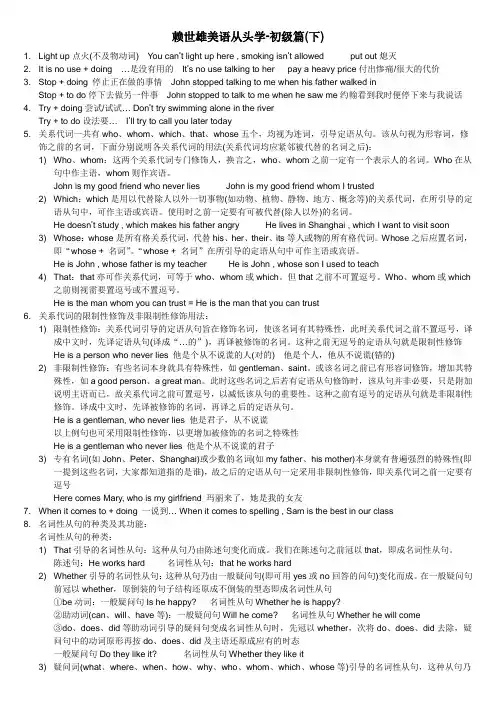
赖世雄美语从头学-初级篇(下)1. Light up点火(不及物动词) You can’t light up here , smoking isn’t allowed put out熄灭2. It is no use + doing …是没有用的It’s no use talking to her pay a heavy price付出惨痛/很大的代价3. Stop + doing 停止正在做的事情John stopped talking to me when his father walked inStop + to do停下去做另一件事John stopped to talk to me when he saw me约翰看到我时便停下来与我说话4. Try + doing尝试/试试… Don’t try swimming alone in the riverTry + to do设法要…I’ll try to call you later today5. 关系代词一共有who、whom、which、that、whose五个,均视为连词,引导定语从句。
该从句视为形容词,修饰之前的名词,下面分别说明各关系代词的用法(关系代词均应紧邻被代替的名词之后):1) Who、whom:这两个关系代词专门修饰人,换言之,who、whom之前一定有一个表示人的名词。
Who在从句中作主语,whom则作宾语。
John is my good friend who never lies John is my good friend whom I trusted2) Which:which是用以代替除人以外一切事物(如动物、植物、静物、地方、概念等)的关系代词,在所引导的定语从句中,可作主语或宾语。
使用时之前一定要有可被代替(除人以外)的名词。
He doesn’t study , which makes his father angry He lives in Shanghai , which I want to visit soon3) Whose:whose是所有格关系代词,代替his、her、their、its等人或物的所有格代词。
1. Rome Wasn't Built in a Day p.1.English is an international language. Therefore, it is necessary for us to learn it. It can be rewarding or just a waste of time. It's up to you. It depends on how you study it. Here are some tips about learning English.First, don't be afraid to make mistakes. You will learn from them. Second, you must not be shy. Be thick-skinned and speak up! Finally, you mush be patient. Remember, "Rome wasn't built in a day."☆foul language 下流话Mandarin 普通话,国语☆Your stay here is just(or only) a waste of time.☆rewarding a.有(获)益的;修得做的,划算的.Teaching is a very rewarding profession.教书是一种很有价值的职业.Exercise is a rewarding for our health.☆by fits and starts.adv.间歇地,断断续续地,一阵一阵地My brother studied accounting by fits and starts, so he failed.☆tip n.①建议②小费③提示,技巧give sb. tips on/about sth. vt.给某人关于某事的建议tip (about) = advice (on)a good piece of advice 不说: a good advice☆stink vi.臭stingy☆be patient with sb. 对...有耐心☆thick-skinnned a.厚颜的Eg:If you want to be a good salesman,you must be thick-skinned.☆Don’t be afraid to make mistake. 别怕犯错.☆It depends on how you study it.那要看你如何去学习.It depend on when you do it.那要看你何时去做.2. How to Improve Y our English p.9.Mack is talking to his friend Don.M: Hi, Don! How are you doing in your English class?D: Not so well, I'm afraid.M: What's the problem?D: I'm not improving. Tell me, how come your English is so good?M: Well, uh…I have an American girlfriend.D: Aha! That's it. Now I know what to do. (He runs off.)M: Hey, Come back! I was just kidding!☆funny farm 疯人院正式:mental asylum☆improve sth = make a lot of improvement in sth☆how come(口) 无需要倒装=why☆talk to(with) sb. about sth. vi. talk sb. into doing vt.说服☆When he gave a speech, we realized that he was just talking nonsense.☆He is a problem studnet.☆greeting 招呼语How are you doing in ...? or: How are you getting along? 近来怎么样?久违的老朋友还可以说:How are you? or How have you been?Howdy 美国南部招呼语answer: Howdy☆blind date 相亲,盲目约会☆I am afraid (that省略) it is going to rain, so we can't go on a picnic. 我认为...(弱语气)☆What's the problem (with)?= What's wrong?= What's the matter (with)?☆goof around 浪费时间,混时间☆Aha, that's it. = Aha, I get it. = I understand.☆kidding = joking3. The City of Song p.13Listening to music is the favorite pastime of many people all over the world. This is especially true for people living in Vienna, the city of song. Being the home of Mozart, this city is the birthplace of classical music and the waltz.Music fills the air in Vienna. Going to public concerts is often free of charge. And don't forget, Vienna is also home to the world famous Vienna Boys' Choir. No wonder people say Austria is always alive with the sound of music.☆Austria Australia jog 慢跑chore 杂物(可数) potbelly 大肚皮He is a potbelly.☆the world over adv. = around the world = throughout the world = all over the world☆maestro 艺术大师,名作曲家☆birthplace 发源地,诞生日classical 古典的classic 经典的☆be free (of charge) 免费的This sample is free of charge.☆be enslaved by 被...奴役be enslaved to a bad habit 改不掉坏习惯☆be home to 某地是…的所在地/出产地/聚集地be the home of 某地是…的故乡/老家☆no wonder + clause(主+v.)adv.难怪Eg:No wonder Bruce is in such a good shape, he excercises.No wonder you’re so thin, you eat so little.☆be alive with a.活的,充满的Eg:The room is alive with children’s laughter.sth. fill the air充满着某物Eg:Romatic love songs fill the air in that cozy Italian restaurant.那家温馨的意大利餐馆充满着罗曼蒂克的情歌.4. He Who Hesitates Is Lost p.21Mike is in Vienna with his girlfriend Daisy.M: Are you having a good time, Daisy?D: Are kidding? I'm having the time of my life. I loved the concerts.M: Concert going is fantastic but what else can we do?D: Biking along the banks of the river Danube could be fun.M: It sounds like a great idea!D: Let's do it then.M: You're right. As they say, "He who hesitates is lost."☆He who(引导表语从句) hesitates is lost. 迟疑着将丧失良机.hesitates to …做…犹豫不决He who…+单数动词“凡是…的人….”= one who.. = those who +复数动词Eg:He who works hard will be successful. "He" means anyone. or: one, those☆I was lost in that music. "沉醉于"= be absorbed in one's work☆While on vacation last year, I visited France and Italy. 渡假☆Chinese character “中国字”不说Chinese words☆The artist will put on (hold) an exhibit next month. (put on 娱乐)☆fantastic = wonderful, great, awesome, terrific (cool for the young) aweful = terrible 糟☆Biking along the bank could be/can be/must be/is fun.☆have 做“有”无进行时态Eg:I have a car. I have time.即,无法说"正在"的词,无进行时态I love you.5. Bungee Jumping p.26Bungee jumping looks like fun. It makes me nervous just to watch someone do it. It certainly takes a lot of guts to jump one thousand feet above the water with only a rope tied to your legs. It scares me just to think about it. However, it is something I really want to do one day.Some people think I'm crazy. They say to jump is foolish enough, but to have to pay for it is madness. I don't agree. For me, to live a short and exciting life is far better than to live a long and boring one. What do you think?☆wild boar 野猪☆Paper originated in China. 起源于☆have the guts(口语)/courage to be. 有做…的勇气/胆量.pluck up one's courage 鼓起勇气muster up one's courageEg:Bill does not have the guts to ask Marry to go out for a date.☆be tied to = be bound (bind) to 被...绑在That poor dog is tied/bound to the fence, he can not run away.☆be scared of = be frightened of Peter is scared of snakes.scare sb. to death 把某人吓的要死.He scared me to death.☆He looked into the mirror and found he looked much older. 照镜子☆cockroach(es) 蟑螂lunatic n.adj疯子luna 月亮(拉丁文)☆get some where有出息get no where 没出息If you work hard you get somewhere someday.☆I agree with you on this point, but I disable agree with you on that point.☆agreeable 相处容易的: I like Marry, because she's a very agreeable personality.☆live/lead + a/an +a. life过着…生活The famous sight lives/leads a simple life.☆boring a.令人厌烦的,无聊的(指事)So boring 真无聊 boring day be bored with a.感到厌烦的(指人)=be fed up with =be sick of =be tired of “受够了”“对…感厌烦”☆What do you think?你认为呢?☆looks /tastes /sounds like(prep.) 后接名词“象”☆知觉动词vt.看:see, watch,look at(注视) 听:hear,listion to 感觉:feel1)vt.+宾+宾补(动原) 强调确有事情发生,表进行时态2)vt.+宾+宾补(现在分词)强调事情正在发生3)vt.+宾+宾补(过去分词) 强调被动的状态6. Nothing Ventured, Nothing Gained p.35Lisa and Bill are talking about their future.L: What's your goal in life, Bill?B: To fly in the sky and feel as free as a bird.L: That's easy.B: What do you mean?L: Go bungee jumping.B: You mush be kidding. It's too dangerous.L: Well, nothing ventured, nothing gained.☆If nothing is ventured, nothing will be gained.☆Everybody shoule have a goal in life.My goal is to learn English better one day.☆Growing up is learning experience.☆pearl 珍珠Pearl 女人名☆carve out雕刻出,开创出Eg:By going to school and studying hard, Sam carved out a good career of his future. ☆attain/reach/fulfill one's goal☆Peter and Bruce are as busy as bees.Ever since sam lived on his own, he has felt as free as a bird.山姆自从独立生活以来觉得自由极了.To fly in the sky and feel as free as a bird.象鸟儿一样在天气自由翱翔。
1. Rome Wasn't Built in a Day p.1.English is an international language. Therefore, it is necessary(/ important) for us to learn it. It(/learning English) can be rewarding or just(/only) a waste of time. It's up to you. It depends on how you study it. Here are some tips about(/on) learning English.First, don't be afraid to make(/of making) mistakes. You will learn (something)from them(the mistakes that you make). Second, you must not be shy. Be thick-skinned and speak up! Finally, you must be patient. Remember, "Rome wasn't built in a day."Well, Rome does not refer to the city of Rome only, it refers to the Roman empire, that is the great country that Rome built more than 2000 years ago. It was a great empire and of course you can not build anything good or great in just a short time .the Roman Empire [ˈɛmˌpaɪr] 罗马帝国Empire--this word is spelled e-m-p-i-r-e. Now, I have this question: in what situation will you use this expression "Rome wasn't built in a day "? Please give us an example.Well, let's say that your friend wants to learn how to do something, like typing or swimming, and at first, your friend feels a little discouraged, because it is not easy to learn a new skill, but you tell him: Hey, come on. Rome wasn't built in a day. We want to encourage our friends with this saying.Your friend is learning how to type. He is a little bit discouraged.We can encourage our friends with this saying. 谚语We say that English is an international language, because English is spoken around the world. Of course, there are more speakers of Mandarin than of English, but English is spoken by more people in more countries than Mandarin is, so, when you travel or do business or study overseas, you can always find English speakers, and English TV programs and English newspapers.In other words, English is a universal/ an international language, that is why we should learn it. Mandarin 普通话,国语Bruce speaks beautiful Mandarin.[ˈmændərɪn]foul language 下流话Your stay here is just(or only) a waste of time.rewarding a.有(获)益的;值得做的,划算的.Teaching is a very rewarding profession.教书是一种很有价值的职业.Exercise is very rewarding for our health. It pays(/is rewarding) to exerciseIt is up to you. 随你吧Well, if Peter asks me: do you want to go to a restaurant first or see a movie first tonight? I might say: it's up to you.Do we go to the movies first or shall we go to a restaurant first? It's up to you .but I know the true answer. He enjoys eating more than anything, let's go to the restaurant first .In our studio[ˈstudioʊ], we have got a small studio over here and we have only two people here, that's Bruce and me, but Bruce is much too big, we have little room left here.by fits and starts adv.间歇地,断断续续地,一阵一阵地If you learn English by fits and starts, you’ll get no where.My brother studied accounting by fits and starts, so he failed.If you give me a tip, I’ll give some tips on how to learn English.if you are in a restaurant, and you leave a little money for the waiter, we say that is a tip小费. But then Peter said I'll give you some tips about learning English. -- some advice about learning English.建议advice un.tip①n.小费②n.建议,提示,技巧give sb. tips on/about sth= give sb. advice (on) sth. n.给某人关于某事的建议③vt.给小费Mr. Bruce, before leaving, don't forget to tip me.④vt.建议tip somebody on something (He tipped me on how to learing English)afraid两种用法:afraid to make(/of making) 即+不定式或+ of +动名词I’m afraid to talk to him. I’m afraid of talking to him.advice un. a good piece of advice 不说: a good adviceWell, you have to speak or write a language to really learn it. if you make a mistake while speaking, usually the listener will understand you anyway, because usually your mistake is just a grammar mistake or maybe a vocabulary mistake, but usually we understand you. But if we don't understand you, we will ask: what do you mean? And then you can try again.Only by making mistakes can we learn sth.Children are often shy around strangers.Well, this is often the case, but there is some situation in which adults are shy. For example, each time Bruce is with me he is shy.-- That's not shy, Peter, that's embarrassed. embarrassed stink vi.臭Peter, you stinks.be patient with sb.对...有耐心A good teacher must be patient with his studentsthick-skinnned a.厚颜的Eg:If you want to be a good salesman, you must be thick-skinned.Don’t be afraid to make mistake. 别怕犯错.It depends on how you study it.那要看你如何去学习.It depend on when you do it.那要看你何时去做.2. How to Improve Your English p.9.Mack is talking to his friend Don.M: Hi, Don! How are you doing in your English class?D: Not so well, I'm afraid. (原:I'm afraid I ’m not doing so well in my English class)M: What's the problem (省do you have with your English)?D: I'm not improving(/I’ve not been improving/ I’ve not made any improvement). Tell me, how come your English is so good?M: Well, uh…I have an American girlfriend.D: Aha! That's it. Now I know what to do. (He runs off.)(=runs away)M: Hey, Come back! I was just kidding!Well, probably they would like to hear you speak English only, so please introduce yourself in English again.However, this is basically an English teaching program. So, every now and then, of course, he ?? and speak Chinese. But most of time, he will explain the key points, if there is any inEnglish. so, lesson 2, we had a very short dialogue. now, by the way, what is the meaning of this word "dialogue "?dialogue/dialog A dialog is a conversation between two people. And that is spelled? Well,you can see it on page 9 here "dialogue", but it is also spelled "dialog". so, there are two spellings for this word. Their pronunciation is exactly the same.…O r sometimes just one person, Peter. because sometimes I hear you talking to yourself. Peter is going to be send to a kind of hospital--funny farm.funny farm疯人院正式:mental asylumHe was raised on the farm.Yesterday Peter was send to a nearby mental asylum, because he kept talking to himself. improve vt.vi. improvement n.-->improve sth = make improvement in sthHe improve d his English by studying every day.=He study everyday, so his English improved. Peter, you’ve made a lot of improvement in your Mandarin. improvement un-- Thank you Bruce for teaching me.because he studies hard, he has made a lot of improvement in his English.①talk to(/with) sb. about sth. vi. ②talk sb. into doing vt.+into说服talk nonsense胡说八道What are you talking about? The teachers were talking about the problem student.He is a problem student. --He keeps causing trouble.His girlfriend talk ed Mike into quitting smoking.When he gave the speech, we realized that he was just talking nonsense.He is a problem student.Hi和Hey区别:"Hi" as you just said, is a greeting. if I see my good friends or sometimes my students, I will say "hi", it's a friendly greeting. but "hey" means I want you to pay attention to me. I have something important to talk to you about or maybe to show you. Hey, come here!Hey, listen to me!--but "hey" in this case is not quite impolite, we should only use it between friends.回答Ok, and you?或者fine, thank you等how are you doing? How are you getting along?久违的老朋友还可以说:How are you? or How have you been?Howdy 美国南部招呼语answer: Howdy(=how do you do第一次见面)If you go to Texas or other southern states in the United States, many people will greet you with Howdy.afraid vt.恐怕+that从句(I think/guess)I am afraid (that省略) it is going to rain, so we can't go on the picnic. 我认为...(弱语气,后带内容比较负面)I’m afraid she is not good-looking. I’m going to have a blind date. blind date 相亲,盲目约会Look into the mirror yourself.What's the problem (with)? It seems that he has some problems with the work.= What's wrong?= What's the matter (with)?I'm not improving. 文中= I have not been improving =I have not made any improvement. how come(口) 无需要倒装=whyBruce, How come you look s o ugly/why do you..? Where’s the hankerchief? The truth hurts. why is he late for class again? how come he is late for class again?How come you failed your Chinese text? Why did you fail your Chinese text?Because I goofed around. I didn't study at all. goof around 浪费时间,混时间Aha, that's it. = Aha, I’v got it. = I understand.Aha, means I understand. I’ve got it. For example, if you are trying to think of the answer to a problem, Let's see, the capital of Canada is. .., aha, is Ottawa.If you try to think of a answer t o a problem, Let’s see: the capital of Canady is? Aha, is Ottawa. run off = run away kidding = joking3. The City of Song p.13Listening to music is the favorite pastime of many people all over the world. This is especially true for people living in Vienna, the city of song(un,=music). Being(可省) the home of Mozart, this city is the birthplace of classical music and the waltz.Music fills the air in Vienna. Going to public concerts is often free of charge. And don't forget, Vienna is also home to the world famous Vienna Boys' Choir. No wonder people say Austria is always alive with the sound of music.Oh, Bruce, you know something? I should leave this lesson to you. Because this lesson features one country and that’s? Austria. This country has a lot to do with your background. So, tell all of listeners, how come you have a very close connection with this country? --My mother was born in Yugoslavia, but her mother comes from Austria, and I still have many relatives living there, and I like to visit them every two or three years.I still have many relatives living there, and I like to visit them every two or there years. Austria Australia The city of song refers to the city of Vienna. --You've been to that city before. Tell us something about this city.Vienna is one of the most beautiful citys I have ever seen. I’m not kidding. It's a very old and beautiful city, full of culture, music and good beer.potbelly 大肚皮Well, if you go out with Peter, because he is a big potbelly, you might feel embarrassed..Jogging (/Going jog/Lifting heavy glasses of beer) is my favorite exercise. jog 慢跑What’s your pastime over the weekend? what's your favorite habit?How do you pass the time on your weekends(每逢周末)?Going to a restaurant and seeing a movie.the world over adv. = around/across the world = throughout the world = all over the world Mikle Jackson is famous the world over.song un=music CN歌曲a song You got to face the music.But here I’m a little bit curious again. Now that you just mention you have something to do with Vienna, how come you don't know anything about music?--That's a good question. Peter means I can't sing. I like to listen to music, but I can't sing.To face the music means that you must face your problem, you must try to solve your problem. He was sick of learning, he ran away from home (being) sick of learning, he …Mozart was one of the most famous classical musicians. maestro [ˈmaɪstroʊ] 艺术大师,名作曲家birthplace 发源地,诞生地what’s your birthplace?=where were you born?In fact, I was born in Nanjing, even though my hometown is in Guangxi province.Sure, this is true. When you go to Vienna, especially in the summer time, you can hear music being played, not from the radio or the CD player, but from the people who play music on the street or in the parks or in the concerts. You can hear music as you walk around the city.In other words, you can see a live shows/concerts on your own. live adj.现场的classical 古典的classic 经典的be free (of charge) 免费的--I work for Peter free of charger. In other words, I am enslaved by Peter.--In fact, the truth is I am a slave to Bruce.be enslaved by 被...奴役a slave toDon’t be enslaved by money= Don’t a slave to moneylet me give our students a better example here: This sample is free of charge.be home to 某地是…的发源地/出产地/聚集地/的故乡/ 老家be the home ofHe is a good boy, he often helps his mum with chores. chore 杂务(可数)You should do some chores.Chicago is home to some of the world’s tallest buildings.That island is home to some special birds.He studies hard, no wonder he passed the examination.no wonder + clause(主+v.)adv.难怪Eg:No wonder Bruce is in such good shape, he exercises every day.No w onder you’re so thin, you eat so little.he is in poor shape.be alive with=be filled with a.活的,充满的Eg:The room is alive with children’s laughter.sth. fill the air充满着某物Eg:Romatic love songs fill the air in that cozy Italian restaurant.那家温馨的意大利餐馆充满着罗曼蒂克的情歌.4. He Who Hesitates Is Lost p.21Mike is in Vienna with his girlfriend Daisy.M: Are you having a good time, Daisy?D: Are kidding? I'm having the time of my life(=having the greatest time). I loved the concerts.M: Concert going is fantastic but what else can we do?D: Biking along the banks of the river Danube could be fun.M: It sounds like a great idea!D: Let's do it then.M: You're right. As they say, "He who hesitates is lost."We have this title "he who hesitates is lost ". Now we have this word "he", in this case, "he" isthe subject. He means anyone or one, those. 凡是......的人He who(引导表语从句) hesitates is lost/a loser. 迟疑着将丧失良机I’m new here, I’ve just got lost. 走失,迷路.He who…+单数动词“凡是…的人….”= one who.. = those who +复数动词Eg:He(/anyone/one/anybody)who works hard will be successful.Those who work hard will be successful.hesitates to … 做…犹豫不决If you have question, don’t hesitate to ask me.I was lost in that music. "沉醉于"= be absorbed in one's workDon’t talk to Morris now, he is lost/absorbed in his work.daisy is a very beautiful little flower. but remember, if you talking about the flower, then we do not capitalized "d".Probably they are on vacation there.I’m sorry, Peter. I don't know what vacation means.In my dictionary, there is no such word as vacation. this means that I work all day/day and night for Peter.While (I was) on vacation last year, I visited France and Italy. 度假have a good time (省in) doing something in介词后只能跟动名词,即使in省have a good time +动名词He always has a good time in(in可省) camping.I had a good time dancing last night. Bruce always has a good time working for me.have difficulty, have a hard time. Forigners ~ learing how to write Chinese characters. Chinese characters “中国字” 不说Chinese wordsBut Bruce can write at least one word, that is 一.have a good time =have fun I had a lot of(/ lots of ) fun/a good time/a great time dancing yesterday.how many kids/children do you have?--I have two kids, same as you. n.小孩子,小山羊Mr. Wang who lives next to me has three ears ! come on ! you must be kidding (me) !are you kidding (me)? v.The artist will put on /hold an exhibit next month.put on/hold a concert/ an exhibit娱乐性、文教性hold a meetingThe artist will put on/hold an exhibit next month.House cleaning is Peter’s favorite pastime/activity.fantastic= wonderful, great, awesome, terrific (cool for the young) aweful = terrible 糟Mozart’s music is fantastic. What do you think of that movie? It was terrific!Biking along the banks could be/can be/must be/is fun. 可能性 大I bike/bicycle/cycle on weekends. n. v.Learning English is fun. fun n.好玩(=a good time) adj.有趣的与funny滑稽的含义不同fun man, funny man Bruce is fun, Peter looks funny. He is a fun man to be with."Fun" we always use with "have a good time ". If you like to do something and it's a good time, you say that's a lot of fun. But if something makes you laugh, then we say it's funny.Make fan of嘲笑The students made fun of the new kid of class. D on't make fun of people. It sounds like a great idea/sounds like a great idea/ sounds like great/ sounds great.I’m going to use a different verb of sense: Tastes like garbage.--Peter’s cooking.He picked up the garbage and threw it into the garbage can.--Let’s go see a movie tonight. --Sounds greathave 做“有”无进行时态Eg:I have a car. I have time.即,无法说"正在"的词,无进行时态I love you.Thanks for listening, see you next time.5. Bungee Jumping p.26Bungee jumping looks like It makes me nervous to watch someone do it. It certainly takes a lot of guts (/courage) to jump one thousand feet above the water with only a rope tied to your legs. It scares me just to think about it. However, it is something I really want to do one day.Some people think I'm crazy(/ a lunatic). They say to jump (/jumping) is foolish enough, but to have(/having) to pay for it is madness. I don't agree. For me, to live a short and exciting life is far better than to live a long and boring one. What do you think?On this page we have a new lesson, lesson five, and we have a picture here. This picture describes a person, and this person, or rather this is not a person, but an animal, but looks very familiar to me. What is it? -- it's wild Bruce, oh..., wild boar.wild boar 野猪This is not the case with Bruce. He would think that Bungee jumping is something that we should do. so, tell us some history about this activity. I think if I remember correctly, it originated in that country New Zealand.That's right, it originated in New Zealand. To originate simply means to start someplace, to start somewhere. New Zealand is an island nation in the south Pacific, is an English speaking country, and it's not very big in population, but some of the people there are really like to have an exciting fun time. so, they had the idea that you could jump from a bridge or jump from a tall building with a rope tied to your leg. Just as we see here in the picture, there is a rope tied to one of the wild boar's four legs, and that rope will stop you from hitting the ground.Paper originated in China. 起源于have the guts(口语)/courage to be. 有做…的勇气/胆量.looks like fun looks/sounds/tastes/smells good (vi.+adj.).looks /tastes /sounds like(prep.)+n 感官不及物动词后不接名词, 但+like+n. “象”looks like fun, tastes like fish感观动词vt. 加宾语后,后可直接接动词原形做宾补,表事实。
赖世雄美语从头学-⼊门篇赖世雄美语从头学-⼊门篇1. How are you=How are you doing=How are you getting along?你好吗?Great, thanks! Fine, thanks! Not bad, thanks! So-so, thanks!What’s up? / What’s happening?近况如何?Nothing / same as usual 没什么/⽼样⼦2. A: see you later B: take care(保重) A: you too3. “Excuse me”或”I’m sorry”之后除可置句点以外,亦可置逗点,再置连接词but,以连接另⼀个句⼦。
but原意为”但是”,但此处不必译出:Excuse me, but where is the station? I’m sorry , but I’m new here4. A:Thank you for your help B:You’re welcome/Don’t mention it/Not at all/No problem5. Where are you from / Where do you come from / what’s your nationality前⾯两个可⽤于询问对⽅的省籍或国籍,但最后⼀句则仅限于国籍6. May I have your name, please?=What’s your name?上列两句均是向对⽅请教姓名的问句。
虽然意思相同,但显然第⼀个问句语⽓较客⽓有礼,多在正式的场合中使⽤。
第⼆个问句则为长辈对晚辈或上次对下属使⽤。
7. How old are you?=What’s your age?以上都是询问对⽅年龄的问句。
咱们中国⼈彼此见⾯可以询问对⽅年龄,但与西⽅⼈交往时,除⾮对⽅主动透露⾃⼰的年龄,否则我们随意询问别⼈的年龄会被视为不礼貌的⾏为。
Lesson 10 What Are Friends For?Jane meets her old friend, Fred.J: Hi, Fred! How's everything?F: Not so good, I'm afraid. Supporting a family is becoming more and more difficultthese days.J: What you say can't be more true. Everything is so expensive. I can hardly makeends meet myself.F: Oh, really? Do you need any money? What I have is not much, but I can loanyou some.J: I'm OK. Thanks for being so thoughtful anyway.F: What are friends for?flatter 奉承flatterymeet with trouble 遇到麻烦meet sbThe chinaman presided over the meeting.meet you halfway 折衷Let's compromise 妥协to reach a compromise招呼语greeting:How are you?How have you been?How are you getting along?How is everything?polite behaviorPeter is afraid/scared/frightened of snakes.cockroach(es) 蟑螂support a family 养家back you up 支持I couldn't care less. 不在乎hardly = almost notToday many city couples both have to work, or they can't make ends meet. 收支平衡We are in need of more parks in our city. = We need more....stingy 小气的get by 说的过去,混过讲解:P: and also here, on page sixty-five there is a dialogue. And this is something that we are going to talk about. And notice this, we are here just to teach u or to help you with your English.B: and today's lesson--Lesson ten is called "what are friends for?"That is easy. To borrow money from.P: In Bruce's dictionary, there is not such a word like "lent". only "borrow".B: Be careful. When I have no money. I have to borrow money from my good friend, Peter. Peter is a kind man at heart. So he lends me money.P: He is trying to flatter me.Flattering will not get you anywhere.Flattery will not get you anywhere.I will lend you some money.I will lend some money to you.I'd like to borrow some money from you.P: Jane met her old friend, Fred.meet withHe met with some difficulties. (遭遇)meet some difficultiesmeet some troublesWe will have a meeting tomorrow.B: The chairman presided over the meeting.preside over主持OK, I will meet you halfway.摺衷一下P: I will compromise with you. This means if Peter wants to sell me something for twenty dollars. but I don't want to pay twenty dollars, I want to pay only ten dollars. But Peter suggests, "Well, I will meet you halfway." Let us compromise. Let us say fifteen dollars, ok?I will reach a compromise with you.Hi, Fred, how is everything?How are you getting along?B: How have you been?How are you?How are getting along?How is everything?P: Jane greets Fred by saying.B: This "verb" has a noun "greeting"."Hi" is a friendly greeting.P: Don't forget to greet him when you see him.This is consider behavior.polite behaviorNot so good, I am afraid.I am afraid that not everything so good.In fact, I have some trouble. I hate to tell you. Now that you bring up this question. Still I have to say, "well, I am not in a good situation."I am afraid that he didn't pass the examination.He didn't pass the examination, I am afraid.I think that he passed the examination.be afraid of sb/sthB: Peter is afraid of snakes.be scared ofbe frightened ofMany girls are frightened of cockroaches.one roachtwo roachesP: Supporting a family is becoming more and more difficult these days. raising a familyB: The weather is getting warmer and warmer.It is getting warmer and warmer.P: hotter and hottercolder and colderI will support you.I will side with you.I will tick sides with you.B: You can say, "I will back you up." I will support you.P: You have my support.What you say can't be more true.What you say is really true.couldn't be more true.It couldn't be better.B: So is it polite for me to say Peter couldn't be more fatter?P: Watch your language!B: I am trying to be thoughtful.Be careful what you say.P: I will fix you!I couldn't agree with you more.I couldn't care less.Bruce, I heard that your girlfriend is going to marry another.I couldn't care less.B: Which girlfriend?P: I don't care at all.Everything is so expensive. I can hardly make ends meet myself.You should do the work yourself.hardly = almost notB: Today, many city couples both have to work, or they can't make ends meet. P: The reason is quite simple. Living in the city can be very expensive.B: It's expensive.P: It is expensive to live in the city.Really? Do you need any money? What I have is not much. But I can loan you some. Are you in need of any money?be in need ofB: We are in need of more parks in our city.P: Honey, I am badly in need of your love.迫切地and what is your girlfriend's response?B: She couldn't care less.P: I have decided to dump you. I will never change my mind. Youstingy person.B: loan = lentP: I am ok.I can get by.I can survive.Thanks for being so thoughtful anyway.Thanks for being so understanding.What are friends for!I should do something to help you.Everyone likes to be friends with him.Everyone likes to make friends with him.。
well ahead of time 尽量提前,副词短语How come = why 但是引导的句子不倒装Austria 奥地利Australia 澳大利亚potbelly 大肚皮,啤酒肚jog n.慢跑; v.轻推on your weekend 有每个周末的意思on this weekend 这个周末all over the world = across the world = around the world = throughout the world = the world over (adv.)face the music = face the troublemaestro n.艺术大师,名作,名家free of charge = free 免费be enslaved by 被……奴役a slave to ……的奴隶He is lost in his work = He is absorbed in his work.Foreigners have a hard time learning how to write Chinese characters.I am having the time of my life = I am having the greatest time.The artist will put on (举行= hold ) an exhibit next month.concert going 看演唱会house cleaningawesome 很棒= terrificawful 很差= terribleis fun > must be fun > can be fun > could be funlunatic adj.精神错乱的,疯狂的;n. 疯子,狂人saying 谚语growing up is a learning experienceNothing ventured, nothing will be gained. = If nothing is ventured, nothing will begained.You must have the guts to try something new.gut n. 内脏,勇气;v. 取出内脏coward, cowardlycourage un.pluck up one’s courage 鼓起勇气pluck n.勇气;v. 拔出(鸡毛等),采集pearl 珍珠carve out a bright futureBy going to school and studying hard, Tom carved out a good career for himself. attain one’s goalreach one’s goalSara reached her goal by graduating with a master degree.fortune 财富stop going around 别瞎混了fulfill 履行,实现,完成My plan is to learn English better. 不用learning,不定式表示未完成的愿望as same as 前一个as 为副词,修饰same;后一个为连词as free as a birdeasy come, easy goWhat do you mean by calling me at midnight.You must be kidding me.spooky adj. 幽灵般的,怪异的,神经质的HalloweenHallowmasput an end to = to end 使结束come to an endexceptionEvery rule has its exceptionThere is an exception to every rule.with the exception of = exceptinconvenient convenient convenience 用来修饰事物修饰人用free or availablewhether that what(等疑问词,不倒装)+ 从句,形成名词从句,可以做主语,宾语side with sb. 与……一致It is known to sb. thatOne is known by the company he keeps 观其友,知其人We teach our children to remember /memorize their telephone numbers by heart. Patter is really a very kind man at heartstay up = seat up 熬夜beat one’s brains: think very hard and long about sth.I stayed up all night and beat my brains but I couldn’t think of the answer. department store 百货公司understanding adj. 体贴,体谅= considerate = thoughtfuln. 理解to one’s understanding 据……所知Kangaroo 袋鼠where there is a will, there is a way 有志者事竟成where = as long as 只要where there is life, there is hopeif you don’t work hard when young, you’ll suffer when old.Being thoughtful simply means thinking of others before yourselfsimply = just 副词,起强调作用That man is very mean, stay away from himYou staying here simply means wasting your timesb. mean to do 有意做……,本打算When I say I mean to do it, I mean it。
疑问代词Whose 的用法练习部分重点复习this, that, these, those. 的用法Same 的用法the same as…the same color as…In the back of的用法===================================================================== Lesson 24 It's Mine===============================Article==================================== Whose test paper is this?It's mine, ma'am.And whose test paper is this?It's Tony's, ma'am.And why are your answers exactly the same as his?Because Tony has eyes in the back of his head.===============================Words==================================== Whose 谁的pron.这是疑问代词(谁的),放在句首。
whose可作形容词性或名词性所有格代词,作形容词性所有格后接名词,作名词性所有格之后不接名词。
This is whose dog? 错,疑问代词要放句首Whose do g is this?这是形容词性,后接名词。
这是谁的狗This dog is whose?错Whose is this dog?名词性所有格,后主语BE动词倒装。
这只狗是谁的ma'am 夫人,女人n.Ma'am 是madam是缩写,读也好读点。
是对女士的尊称,对男士用sir。
2012-2-11、cling on to:紧紧抱住,死抱不放;cling to:坚持,依恋,依靠2、convince 的用法convince sb. to do something/convince sb. of something (参见赖世雄语法5-授予动词)/convince sb. that/convince oneself ofbe convinced (of)/be convinced that3、tip (C): 小费 a tip/a large tip/a big tip/a generous tip/ a $5 tip忠告 =a piece of advice, a few of tips/handy tips/gardening tips4、compare, contrast/compare and contrast(比较与对照写法)compare 指把人与人或物与物之间的相同点或异同点进行“比较”、“对照”或“相比”,常与介词with 连用,也可指将人与人或物与物之间的相似处进行“比拟”;还可指将某人或某事“比作”另一人或另一事物。
指后面两种情况时,它常被用作不及物动词,与介词to 连用.contrast 指为了明确其相异之处,将一物与另一物加以“比较”或“对照”,用法和compare 一样,常接介词with 。
虽然很多人将compare 看作是contrast 的同义词,但compare 常用来比较同类事物;而contrast 则常被用来比较非同类事物。
2012-2-21、英语倍数表示法(1)X times+as …as …:是... …的X 倍/more than + X times +as …as …:是... …的X 倍不止;(2)(more than+)X times +the (或所有格)+名词+(of ):是... …的X 倍(不止);(3)X times +比较级+than :是... …的X 倍。
2、英语倍数增减表示法(1)increase (speed up, step up, raise, rise, go up, grow) / increase (speed up, step up,raise, rise, go up, grow) +by+X times :是... …的X 倍/增加了X-1倍;(2)increase (exceed, speed up, step up, raise, rise, go up, grow)+by a factor of +X:是... …的X 倍/增加了X-1倍;(3)decrease (drop, fall, weaken, shorten, reduce, step down, speed down, go down)+(by): 是... …的X 1/减少了XX 1-; (4)decrease (drop, fall, weaken, shorten, reduce, step down, speed down, go down) by a factor of +X: 是... …的X 1/减少了X X 1-。
2012-2-3 赖世雄经典英语语法1、(p3)不定式与动名词作主语时,往往会因为形式主语太长,用it 作形式主语。
但动名词移至句尾时,通常改为不定式短语。
例:To study abroad is my greatest desire.=It is my greatest desire to study abroad.Listening music makes me happy .=It makes me happy to listen to music.例外:It is no use +动名词短语=It is useless +不定式短语=It is of no use+动名词短语=There is no use/sence/point+in+动名词短语2、(p9)名词性从句作介词的宾语a. 慧(whether),怡(疑问词)可以,但代(that)不可以。
I am worried about whether he can do it.√I am curious about how he will cope with this problem.√I am sure of that the team has won the game.×b. 遇有介词,但非要使用that从句时,其补救方法如下(1) 介词+the fact+that从句I am sure of the fact that the team has won the game.I am worried about the fact that he does not study.(2) be+adj+that从句I am sure that the team has won the game.I am worried that he does not study.3、(p199)所有格与动名词的关系a. that从句作主语时,可改为动名词That he teaches well is something that pleases me.His teaching well is something that pleaes me.b. 在介词及某些动词后不可以用that从句,此时可改为:所有格+动名词(1) 遇介词的情况I am worried about that he does not study.×I am worried about his not studing.√In spite of that the sun shone, the air was very cold.×In spite of the sun’s shining, the air was very cold.√I insist on that he should go there.×I insist on his going there.√备注:that 从句主语是物而非人时,一般不用所有格,直接将主语作宾语即可。
In spite of the sun’s shining, the air was very cold.In spite of the sun shining, the air was very cold.√口语中,that从句的主语即使是人,宜采用本结构。
I insist on his going there. (正式)I insist on him going there. (非正式)(2) 遇某些及物动词的情况that引导的名词性从句可作表认知的及物动词( think, feel, find, believe…) 以及表意愿的及物动词(hope, wish, expect, desire…)的宾语。
I believe that he works hard.I hope that he may joint us.但表喜欢、厌恶之类的及物动词,如like, dislike, enjoy, mind等就不可接that引导的从句作宾语,应改为所有格+动名词。
I don’t like that he smokes here.×I don’t like his smoking here.√I don’t enjoy that John joins us.×I don’t enjoy John’s joining us.√备注:mind 可接if引导的从句Would you mind that I open the window?×Would you mind my opening the window?√Would you mind that if I opened the window?√(虚拟语气表客气)4. (p42)不完全及物动词a. 认定动词(1) We regard/look upon/think of/see/view him as a genius.(2) We mistook the long-haired boy for a girl.(3) We consider/deem/think him to be a genius.备注1:to be可省略。
备注2:(1), (2) 里面的as与for后面亦可接形容词作宾语I regard his behavior as inappropriate.John works hard, so I take it for granted that he’ll be successful someday.(4) think, believe, find, deem, consider等五个动词作不完全及物动词时,不得直接用不定式与that引导的名词性从句作宾语,一定要用形式宾语it取代。
I think to climb mountains fun.×I think it fun to climb mountains.√I find that he sings so well wonderful.×I find it wonderful that he sings so well.√b. 使役动词之make, have, getmake/have+宾语+原形动词(过去分词表被动)(作补语)get+宾语+不定式(作补语)make可用于被动语态,have、get则不可以。
He was got to wash the car.×He was had to wash the car.×He was made to wash the car.√c. make的用法(对应于宾语补语的倒装,见刘毅语法宝典p666)如果宾语是不定式,动名词,或由that和whether所引导的名词性从句,又有宾语补语时,应用it代替这类长宾语。
He made to get up early a rule.×He made it a rule to get up early.√I had made whether I am to go or not clear.×I had made it clear whether I am to go or not.√备注:长宾语时亦要倒装He made his meaning clear. √He made his strong objection to the proposals clear. ×He made clear his strong objection to the proposals. √5. (p46) (刘毅P323)授予动词, 间接宾语与直接宾语颠倒时,就需要另加介词to, for或ofa. to 表示给予(give, lend, bring, show, tell, write, send, hand, teach, offer, sell, promise, pass等)He gave me a watch.= He gave a watch to me.b. for 表示代劳(buy, make, leave, do, choose, order, sing 等)One must do someone a good deed every day.= One must do a good deed or someone every day.c. of 表示从……之中的概念(ask, expect, require, demand等)He asks me a question.= He asks a question of me. (of = from)d. 有些需要介词at, against, on(throw, bear, play等)The naughty boy threw a stone at the bird.The thief bears a grudge against the policeman.备注(1)有些双宾语动词只适用于无介词情形,如answer, envy, forgive等。